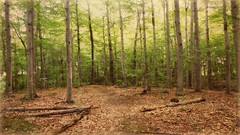 |
| Alaska forest - trees (Photo credit: blmiers2) |
There can be no doubt amongst anyone that studies the environment as a whole that climate change is now a reality and has contributed to rising temperatures on a global scale.
And as the temperature increases, even by a fraction of a degree, these small but significant variances can influence natural evaporation events to such an extent that the timings and underlying nature of plant growth itself is being changed forever.
But climate change does not only alter the basis of plant life, it also changes the fundamental dynamics between pests and disease as well as the very foundations of the animals that can live and thrive in different areas of the globe.
Such changes have had huge implications for those working within the agriculture industry that have found their farms and ranches much less profitable and viable than ever before and the species and varieties of animal they are able to farm much different to those they have experienced in the past.
As the problem of climate change has predominantly been caused by burning fossil fuels and deforestation, by carefully reintroducing more trees into the areas that have been most greatly impacted, we can in fact start to re-absorb some of the CO2 that has been emitted and slow down the process of climate change that we have experienced over recent years.
However, the benefit of introducing trees into the environment is not exclusive to the CO2 absorption they provide. In addition, planting sustainable woodland on agricultural land has become a way for many to seek an alternative income source that is much less influenced by changes in the environment and can provide a stable way of living into the future.
This combination of trees and agriculture, commonly known as Agroforestry may well be the solution both in terms of environmental issues and also economic challenges that many landowners now face.
By identifying the correct types of trees that thrive in the local area and focusing on planting them in sufficient numbers, land owners not only establish protection for the environment but also take back control their personal livelihood.
Furthermore, the shade of forest trees can provide habitats to a number of diverse forms of wildlife which can bring back a natural equilibrium to the land and the roots of the trees are able to trap sediments and nutrients into the soil, enabling further plant life to thrive within the canopy provided.
While the trees are growing, the natural barriers that they provide can also ensure that the wild stock on the land are preserved and have a greater opportunity to thrive than ever before.
Though clearing agricultural land for forestation would be economically enviable for the farmer if they are planting for carbon absorption alone, by planting the right types of timber that provide a high sell on value to the land owner, this combination of agriculture and forestry could mean that trees themselves could be both a short-term and long-term solution to the challenges we now face.
At silvinvest we highlight several superb sustainable Forestry Investments. Register at http://www.silvinvest.co.uk to gain access to the Sales Brochures and interact with our Potential Returns Calculator. Silvinvest is an information and business development website.
Article Source: http://EzineArticles.com/?expert=Ian_R_Harlock
http://EzineArticles.com/?The-Role-Of-Trees-In-Climate-Change&id=7233249

No comments:
Post a Comment